Living with Water: A museum’s transformative approach to flood mitigation
by Katie Daniel | March 26, 2018 3:17 pm
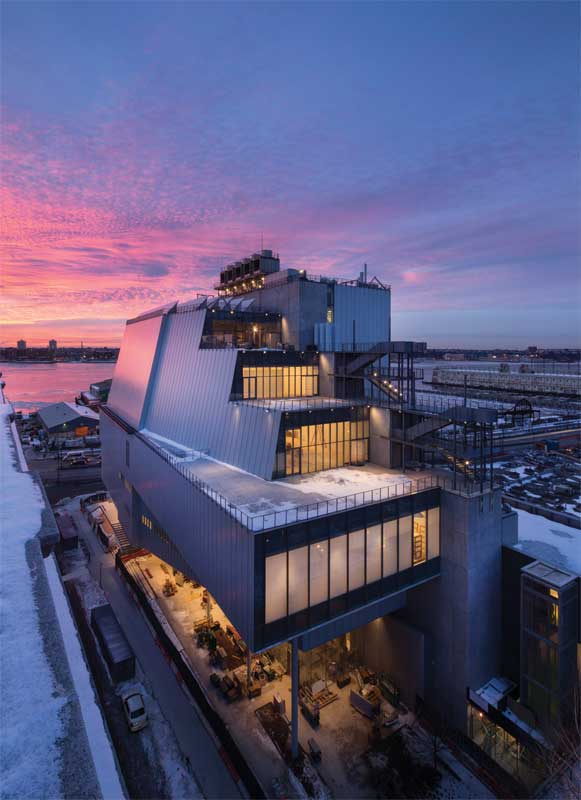 [1]
[1]by Scott Newman, FAIA
As architects and engineers consider design responses to climate change, Building owners’ priorities and cost will drive specific strategies and scope to mitigate the risks of extreme weather. In all cases, the safety and protection of occupants is paramount. Beyond this obligation, however, the level of protection
of the capital investment, and the recovery response time are variable considerations. For museums and other collecting institutions, safeguarding the exhibits and collections is central to their mission. Design professionals undertaking these projects must now consider resilient design as a key requirement.
The Resilient Design Institute defines resilient design as “the intentional design of buildings, landscapes, communities, and regions in response to vulnerabilities to disaster and disruption of normal life.”
The location of the new Whitney Museum of American Art is particularly sensitive to water-level rise and storm surge. The 20,438-m2 (220,000-sf) museum in New York City is adjacent to the Hudson River. The building’s design anticipates the effects of climate change and protects the museum’s staff and collections from severe flood storms through both planning and resilient design features.
The new building opened in the spring of 2015, and was immediately recognized for the innovative way the architecture responds to its unique setting between the Hudson River and the High Line Park. The eight-story museum has both visual transparency and outdoor terraced galleries making connections among visitors, exhibits, and the surrounding city and riverfront. While the design treats the river as an asset central to the visitor experience, the design team also had to respond to the risks posed by its proximity.
The architects, Renzo Piano Building Workshop in collaboration with Cooper Robertson, initially designed the building in accordance with standards set by the American Society of Civil Engineers (ASCE) for structures in flood hazard areas to meet or exceed requirements of the National Flood Insurance Program (NFIP), which is administered by the U.S. Federal Emergency Management Agency (FEMA). These standards are derived from ASCE 24, Flood Resistant Design and Construction, and include anchoring of the pile foundation and building structure to “resist flotation, collapse, and lateral movement due to the effects of wind and flood loads acting simultaneously on all building components, and other load requirements” of the New York City Building Code.
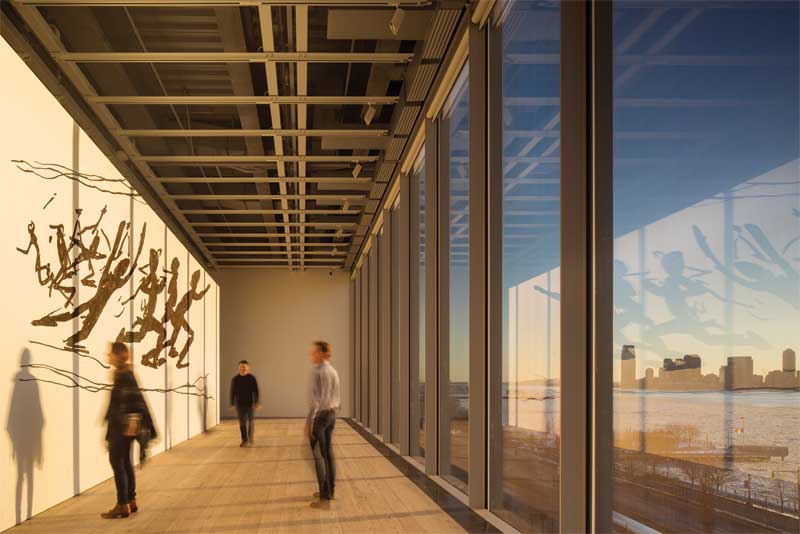 [2]
[2]The original design for the building was planned to resist and mitigate the potential impacts of severe climatic events. The ground floor was elevated by an additional 0.3 m (1 ft) above the levels recommended by FEMA before superstorm Sandy. No significant gallery spaces or art storage was planned to be located below level five. When Hurricane Sandy hit New York City in October 2012, the museum was well under construction and, while not yet enclosed, some basic elements of the building’s design were already in place to protect the structure in case of flooding.
The timing of the storm enabled the design team to observe how the building would perform in a serious flood event. The structure withstood the hurricane well, but a historic storm surge brought unprecedented high water levels, with more than 22.7 million L (6 million gal) of river water filling the building’s 9-m (30-ft) deep open basement. The devastating effects of the storm on New York’s infrastructure transformed flood-mitigation design, and the timing of the Whitney Museum project placed the design team at the forefront of resilient building design.
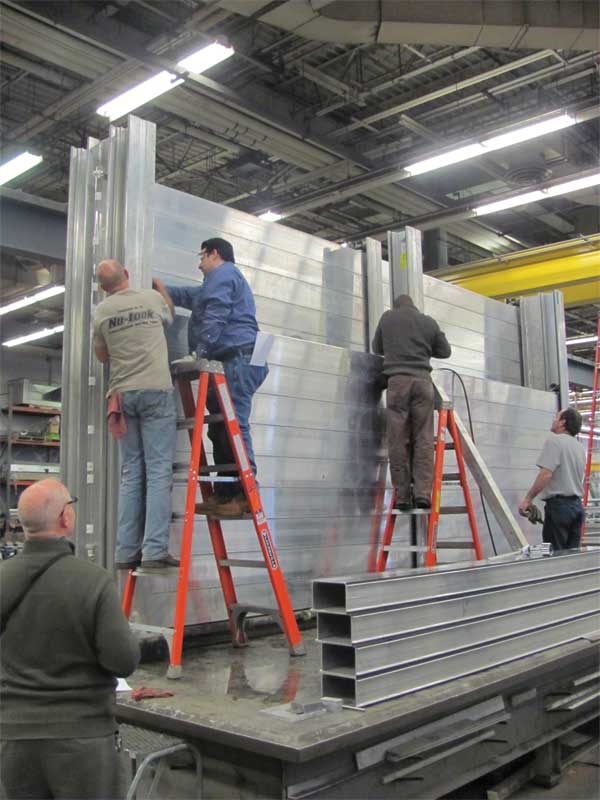 [3]
[3]Photos courtesy Cooper Robertson
Following the storm, FEMA revised its flood zone maps to recommend an additional 1.4 m (4.5 ft) of elevation for buildings in the Whitney flood zone. As is the case with all federal flood standards, this new FEMA elevation did not account for sea level rise. To define a more realistic storm surge level and mitigation design criteria, the Whitney team conducted an international search for an experienced advisor. They selected two groups well versed in protecting urban environments from floods: WTM Engineers of Hamburg, Germany, and their partner, the Franzius Institute for Hydraulic, Estuarine, and Coastal Engineering of the Leibniz University in Hanover.
The analysis was particularly complex, since the design criteria had to account for the combined actions of extreme storm surge heights, locally wind-generated waves, and the Hudson River hydrology, which is tidal. The Franzius Institute was uniquely qualified to undertake this study with both large and shallow wave basins for actual physical modeling of coastal hydrodynamics, wave actions, and impacts on flood defense systems.
The Franzius Institute undertook an extensive study of New York Harbor and its environmental history, and advised the building should be protected to a higher elevation of 5 m (16.5 ft), anticipating sea level rise. Following the recommendation, the project team worked with WTM Engineers to design modifications, both permanent and deployable, to Whitney’s structure as protection against future storms. These improvements were not required legally since Whitney’s building permit remained in force according to the codes in place at the time of filing, and updates to the ASCE standards or FEMA mapping would not apply to the project retroactively. However, by using project-specific, proprietary, and context-specific design criteria, the Whiney team was able to develop innovative solutions exceeding the broader code and standard changes being considered, and ultimately enacted.
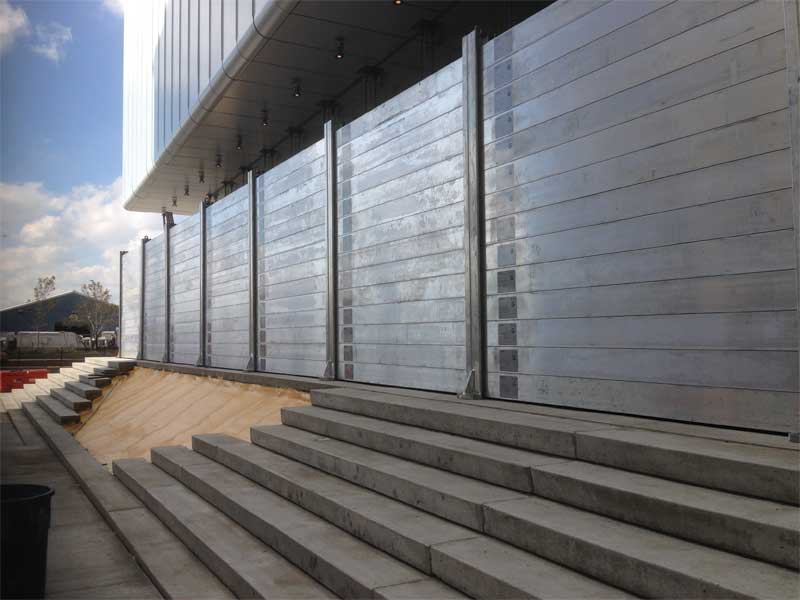 [4]
[4]Recalibration and retrofits
In the case of flooding, the main goal is to preserve the ground floor integrity as completely as possible, which ensures the entire building is safeguarded. To do this, the team examined all possible water infiltration points within and above the 5-m protected elevation. Reinforced concrete walls form the cellar and protect the building on four sides, but the loading dock and staff-entry doors on the west side of the building are at street level—an elevation of 1.8 m (6 ft). To protect this potential water-entry point, the team employed floodgates comprising a 250-mm (10-in.) thick aluminum plate with a hinge, thus sealing out water by locking with steel plates embedded into reinforced building liner walls. Only two Whitney facilities staff are needed to close the gates in case of an emergency.
Cooper Robertson redesigned the surrounding structure to accommodate the floodgates. The reconstruction on the building’s west side required the removal of precast concrete from the already built stair tower. During this process, the precast concrete on the levels above had to be temporarily secured in place by shoring while the new section incorporating the floodgate could be installed.
A crucial element in Whitney’s flood mitigation strategy is continuity because the floodgates only work if the rest of the building is continuously sealed. High-density polyethylene (HDPE) sheet waterproofing membranes behind the secondary reinforced concrete walls shield the structure from flooding. Foundation waterproofing was used to seal concrete penetrations made for electrical conduits, gas and electrical services, and piping, thereby maintaining the structure’s integrity.
 [5]
[5]Photo © Nic Lehoux
The design team also devised a temporary barrier wall protective system to be deployed in anticipation of major flooding. According to storm event protocols, a private contractor will bring Whitney’s temporary barriers from a nearby warehouse and assemble them onsite. A continuous concrete curb on the building’s plaza supports vertical aluminum posts bolted into the plaza which hold horizontal aluminum “logs.” The temporary barriers will protect the lobby’s large expanses of glass walls that could be vulnerable to pressurized water. Extensive structural reinforcement was added to the plaza concrete to accommodate the anticipated water weight. The plaza’s drainage system was also redesigned by the project’s plumbing engineers, Jaros Baum & Bolles to utilize the building’s 121,133-L (32,000-gal) storm water tank and sufficient pumping capacity to mitigate the impacts of maximum rain intensity, as well as possible leakage and overtopping of the temporary flood barrier. Drains outside of the temporary barrier will be shut off according to protocols in the standard operating procedures manual.
Worst-case scenarios
An additional change to the original building design included rethinking the building’s emergency energy sources. Instead of the 3785-L (1000-gal) fuel tank originally planned for the museum, the building’s insurance advisors suggested accommodating the largest tank possible. Therefore, the building has a 15,141-L (4000-gal) tank, which provides as much emergency fuel as possible. This allows the building’s systems, particularly the pumps, to run for a far greater duration than originally planned. The team did precise calculations to account for numerous flooding scenarios, including the failure of various functions. For example, if the water pumps should fail, it was determined water may then flood the basement. Therefore, the placement of all electrical equipment was adjusted to sit 355 mm (14 in.) above the finish cellar floor elevation. In cases where this was not possible, a concrete barrier provides perimeter protection.
In the worst-case scenario of a flood above the 5-m elevation, the structure is designed to withstand flooding of the lobby level, deflect the force of any debris impact loads, and prevent any stray building materials from blowing off the structure and causing damage or injury. The design gives museum staff the confidence the building will not harm the community during an unprecedented future weather event. However, the severe impact of a flood of this magnitude would supersede the goal of resuming building operations quickly.
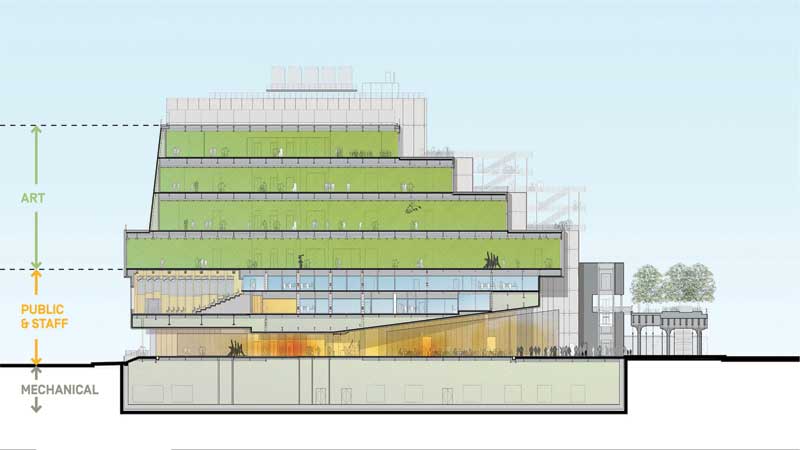 [6]
[6]Standard operating procedures
An essential part of the museum’s flood protection program is the proper and timely implementation of actions and procedures before, during, and after a storm surge or other flooding event. To ensure correct procedures are followed by Whitney staff, a standard operating procedures manual was created, containing checklists, flow charts, drawings, and manuals. Key to this document are a Team Organization/Responsibilities chart showing team roles and reporting structure, and General Alert Flow Chart by phase, tracking a storm’s path and intensity paired with actions and evacuations based on the likelihood of impact and severity of the storm.
Taken together, this five-part approach of good planning combined with fixed, deployable, technical, and operational flood protection measures allows the building design to take full advantage of the unique characteristics of its site while offering a complete system of resiliency to resist future storm surges, as well as protect the staff and collections from severe weather events. It demonstrates how a project with ambitious design goals can also be responsive to a changing climate and associated risks in ways that are invisible to the public, resulting in award-winning architecture.
Scott Newman, FAIA, leads the cultural practice at Cooper Robertson. He has nearly 40 years of experience in the planning and design of complex museums, and was partner-in-charge of the new Whitney Museum of American Art. Newman can be reached at snewman@cooperrobertson.com[7].
- [Image]: https://www.constructionspecifier.com/wp-content/uploads/2018/03/3waterproof.jpg
- [Image]: https://www.constructionspecifier.com/wp-content/uploads/2018/03/4waterproof.jpg
- [Image]: https://www.constructionspecifier.com/wp-content/uploads/2018/03/2waterproof.jpg
- [Image]: https://www.constructionspecifier.com/wp-content/uploads/2018/03/1waterproof.jpg
- [Image]: https://www.constructionspecifier.com/wp-content/uploads/2018/03/5waterproof.jpg
- [Image]: https://www.constructionspecifier.com/wp-content/uploads/2018/03/10waterproof.jpg
- snewman@cooperrobertson.com: mailto:snewman@cooperrobertson.com
Source URL: https://www.constructionspecifier.com/living-with-water-a-museums-transformative-approach-to-flood-mitigation/